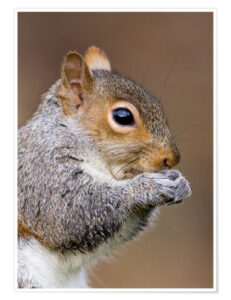
The Grey squirrel (Sciurus carolinensis) is classified as an invasive, non-native species, appearing in Schedule 9 of the Wildlife and Countryside Act 1981. This is in need of change.
Wildlife and Countryside Act 1981 states that if any person releases or allows to escape into the wild any animal which a) is of a kind not ordinarily resident in and is not a regular visitor to Great Britain in a wild state; or b) is included in Part I, Schedule 9. he shall be guilty of an offence. There in the list of animals, listed in Schedule 9 Part I as Non-Native animals which are established in the wild, is the grey squirrel.
The Act states a species is ‘invasive’ if, not under the control of any person, would be likely to have a significant adverse impact on, a) biodiversity, b) other environmental interests, or c) social or economic interests.
Grey squirrels have been in UK since they were introduced in Victorian times, over 130 years ago. As John Bryant states, they are as British as we are. Non-native status has the taint of xenophobia and racism and has implications in how we see human residents from other countries. By this invasive non-native species classification there is no time period in which an introduced species becomes excepted as native. It is in DEFRA (2009) view that for a species to be considered ‘ordinarily resident in a wild state, ‘the population should have been present in the wild for a significant number of generations and should be considered to be viable in the long term.’, making the grey squirrel Native in that context and thereby appearing in Schedule 9 as a subjective analysis of its perceived detrimental qualities.
We see exactly the same offences again in newer legislation. The Invasive Alien Species (Enforcement and Permitting) Order 2019 – ‘person who releases or allows to escape into the wild any specimen which is of a species of animal which a) is not ordinarily resident in and not a regular visitor to Great Britain in a wild state, or b) is included in Part 1 of Schedule 2 is guilty of an offence. There listed in Part 1 Schedule 2 are the Chinese Mitten Crab, Red Swamp Crayfish, Signal Crayfish, Spiny cheeked crayfish, Muntjac deer, Ruddy Duck, Egyptian Goose and grey squirrel. Non-native, invasive and alien.
Both the 1981 Act and the 2019 Order prevent an injured or orphaned grey squirrel, brought back to health or maturity, being returned to the wild. It criminalises compassion. Culling and killing operations are legalised. Vets and the RSPCA and wildlife hospitals are impelled by the state to kill healthy wildlife.
As we have no monkeys in the UK squirrels fill this niche. There are no red squirrels in large parts of our towns, cities and countryside. There is not ever likely to be. Destroying grey squirrels does not mean reds will take over the niche. It will leave an emptiness. The attitude of the population as a whole appears anecdotally to be ambivalent, loved and disliked in fairly equal measure. But significantly grey squirrels appear to be vilified by an influential proportion of the landed establishment, law makers and people that speak as conservationists. Grey squirrels are often described as tree rats, destroyers of trees. Humans destroy trees. (50% of ancient forests destroyed since World War II (Bryant) Perspective is needed. A small furry animal only. It’s never right to denigrate and single out a people to persecute because some people define them as ‘other’ and there are few if any good reasons to do the same to animals.
Pests. What a damming word. The Mammal Society with a mission to save wildlife describes grey squirrels as serious pests of forestry, serious pests in gardens and among horticultural crops. This a species devalued by economics. What voice for those who do not define animals by Economics; those who value life, beauty, that value mental wellbeing, diversity and biology?
Being Native is not a criterion to be offered protection by legislation.
The Game and Wildlife Conservation Trust believes that predator control is an essential part of game and wildlife conservation. They can be found at agricultural shows telling the public that grey squirrels are pests, along with foxes, stoats and magpies, while supporting the release each year of 37 million pheasants (GWCT figures) or 47 million (RSPB figures), a non-native species, into the countryside to be shot, and as the RSPB says, damaging the countryside, affecting plants, reptiles and other wildlife. It is only very recently that a Variation of Schedule 9 was enacted in 2021 to include the common pheasant and red legged partridge in Schedule 9, meaning these can now be released only under licence. According to GWCT 16% of released pheasants survive until after the shooting season implying a growing population. The difference between pheasants and grey squirrels, both with a long history of being ordinarily resident in the UK and the reason why pheasants are still being actively released and wildlife is being actively killed to support pheasant populations is politics and economics.
Despite the Hunting Act 2004 shooting foxes as pests remains lawful. Before the act 21,000 to 25, 000 killed per year. Now its estimated 80, 000 are shot annually, half by game keepers, and 10, 000 killed by pest controllers in urban areas.
It’s hard to see logic, science and precautionary principles in play. The UK government it has also legalised the killing of more than 100,000 native badgers in the last 8 years. Badgers, and their setts have legal protection under the Protection of Badgers Act 1992, making it an offence to wilfully kill, injure or take a badger. Natural England at the behest of DEFRA, will sign a licence to accomplish the governments Bovine TB strategy, that with a pen stroke changes the badger status from ‘protected’ to killable. Not being able to see what happens in our backyard while wringing hands at the loss of orangutans or tigers is a blindness that will, with certainty, judge the slaughter of badgers as a stain on our generation. The conclusion is that killing of wild animals is something that our nation champions in any perceived wildlife human ‘conflict’, no matter the ecological crisis and loss of biodiversity internationally.
There are also numerous species that are not native to the UK but which are not considered invasive. Such species either have little impact on the habitat into which they are introduced, or offer positive benefits. They include most crop plants, many farmed animals, the edible dormouse. In 1793 continental red squirrels were imported to save the species from extinction. In the late 1800s at peak numbers the red squirrel was slaughtered in their hundreds of thousands for being essentially a pest (Bryant). Between 1900 and 1925 red squirrel numbers declined drastically under human persecution. Mass killing of grey squirrels now take place across the UK notably in Anglesey and Scotland. Red Squirrels are dominant in Europe and grey squirrels dominate in UK. As Animal Ethics (2014) puts it, ‘The real problem is that humans want to kill innocent animals because of human preferences for certain species to exist in certain areas in certain numbers.’ Climate change will likely awaken debates as to what constitutes native species as animals and plants will inevitably move over time to climes that best suit their survival. Being open to urban rewilding policies that actively encourage us to live, with rather than destroy wildlife in our cities and towns are an outcome for a renewing of nature’s abundance. Classifying the grey squirrel as Native would likely change little in terms of numbers and management policies because being Native is neither a criterion for protection or rampant expansion in species numbers. It would be as much a philosophical standpoint as a legislative one.
Embracing grey squirrels as Native is to consider the interests of grey squirrels as sentinent beings, morally, regardless of their species or classification; to call the grey squirrel Native is to make a stand for the positive benefits they bring to many people; in terms of their mental well being and the joy they receive; to call the grey squirrel Native is to be able to care for wildlife that we can be sure can be returned to the natural world. Being native would confer these benefits. It would demonstrate greater moral values in our interaction with wildlife and challenge the traditional economic theories of externality of nature for other than its resources.
Grey squirrels are part of our environment and, after more than 130 years, it’s time to reclassify and value them as one of our own, to take them off Schedule 9 and bring an end to their classification as a non-native species.
They are as British as we are.
References
Wildlife and Countryside Act 1981 (legislation.gov.uk)
John Bryant – historygreysquirrels.pdf (www. animalaid.org.uk )
Myth Busters: Grey Squirrels – Animal Aid
Guidance on Section 14 of the Wildlife and Countryside Act 1981 Published 21/12/2009, Amended 21/05/2010 Wildlife and Countryside Act (publishing.service.gov.uk)
Species – Grey Squirrel – The Mammal Society
Pheasant – Game and Wildlife Conservation Trust (gwct.org.uk)
Fate of released pheasants – Game and Wildlife Conservation Trust (gwct.org.uk)
what-is-rear-and-released-gamebird-shooting.pdf (rspb.org.uk)
Pheasant and partridge classified as species that imperil UK wildlife | Rural affairs | The Guardian
Red Fox Mortality & Disability | Wildlife Online
New mass badger culls to be banned after 2022, says minister | Badgers | The Guardian (2021)
The place that has wiped out grey squirrels – BBC News
The massive killing of grey squirrels in Europe continues — Animal Ethics (animal-ethics.org) (2014)
Pheasant and partridge classified as species that imperil UK wildlife | Rural affairs | The Guardian
New mass badger culls to be banned after 2022, says minister | Badgers | The Guardian (2021)
The massive killing of grey squirrels in Europe continues — Animal Ethics (animal-ethics.org) (2014)
Invasive Alien Species – Environment – European Commission (europa.eu)
